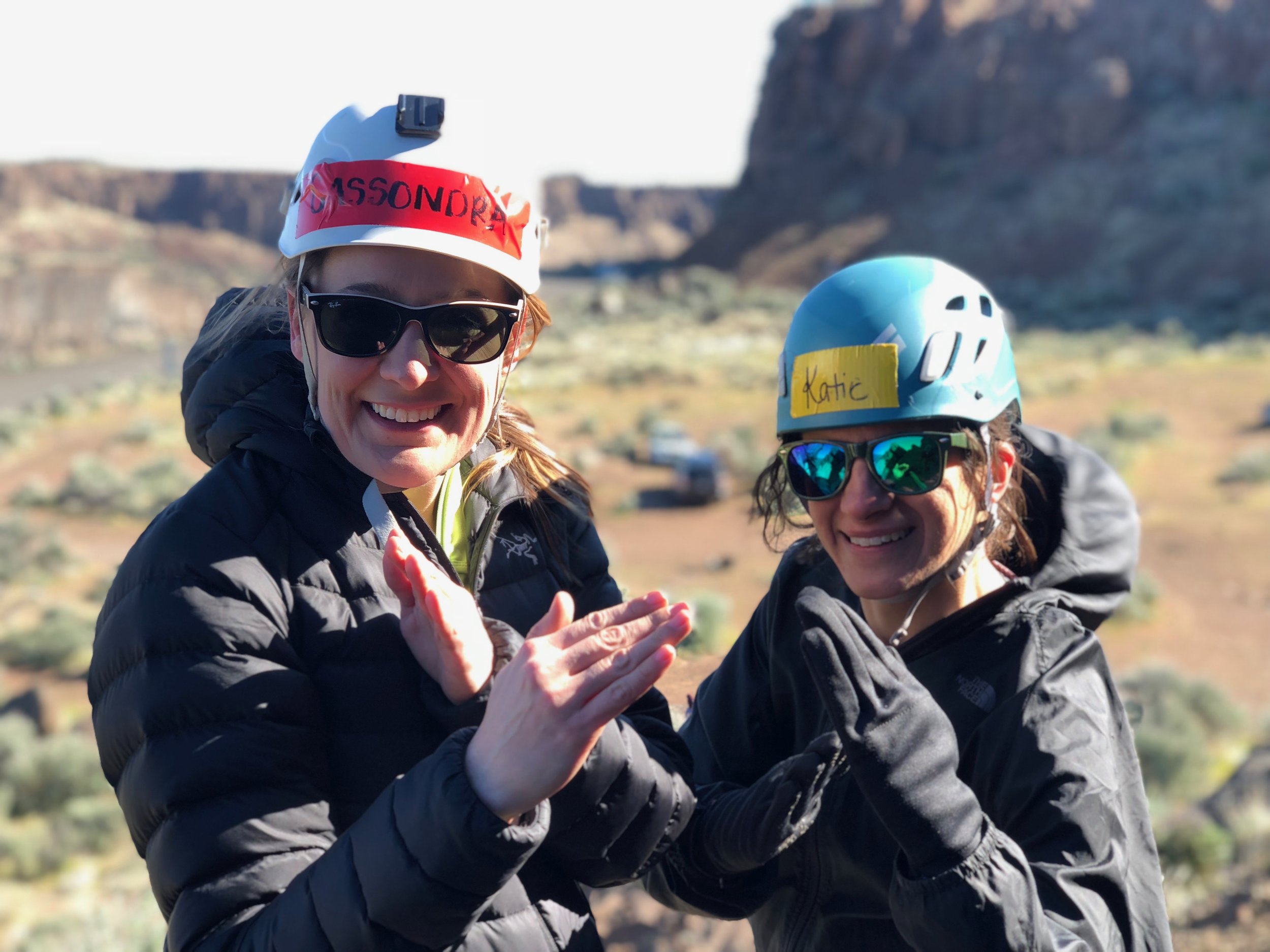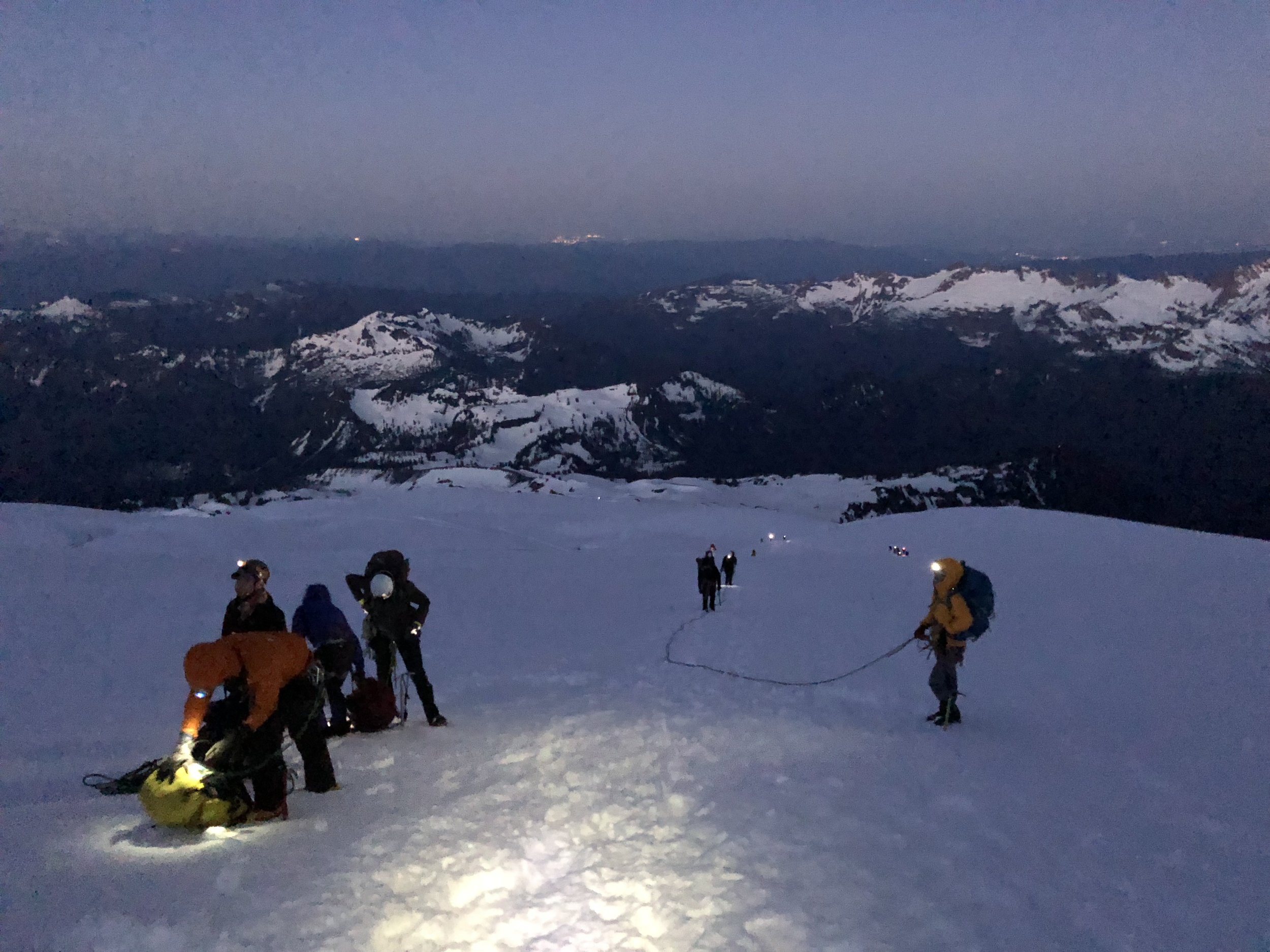I had just passed mile 22 of the Mt. Baker Ultra, a 50-mile race from Concrete, Washington to the top of Sherman Peak and back when I realized something wasn't right.
"I feel drained," I thought.
The weather was perfect. The aid stations frequent and well-stocked. But something was wrong inside of me.
A quick photo before I turned back and headed down the mountain. My race was over.
As planned, I had just transitioned from running shoes to boots and snowshoes and began trekking up the snowfield with the other competitors to the last stage of the out-and-back-course. I was less than four miles from the summit. Now trekking uphill, I had slid to last or nearly last in the group of 17 runners and felt depleted of energy, despite resting the night before and taking it easy on the first half of the race from Concrete. At around 8,000ft I made a judgement call. I turned back and descended down to the last aid station.
"I need to sleep. I don't feel well" I told the aid station workers.
Defeated, I slumped in the camping chair and rested at the aid station for a few minutes. After regaining my wits, I walked and then slowly trotted down the forest service road, and then retraced my steps back to the start/finish of the Mt. Baker Ultra. While I completed 45 of the 50-mile course, I felt dejected when I made it back to my car. My plan was to summit Mt. Baker's Sherman Peak… and I had failed.
I knew I had to come back to make it right.
My original plan was to return that same summer with a friend who was an experienced mountaineer and who could guide me up the glacial ascent. Unfortunately schedules got filled and I ended up missing the weather window for the climb. Oh well. I'd have to take matter into my own hands.
That fall I applied and was accepted into the Washington Alpine Club's Basic Climbing Program. Starting in February, I attended four months of weekly classes and weekend outings with a class full of impressive beginner mountaineers and outdoorsman. We would learn all the rock and snow skills needed to travel safely in the outdoors from volunteer instructors and program co-chairs—many of whom were previously WAC students themselves.
The goal of the class (and our graduation) was to put our skills together at the end of the program by climbing the10,781’ peak Mt. Baker—or at least that was the plan. However for the past three years weather kept students from summiting. I hoped our luck would be different.
I found the WAC program very challenging. The knots test was intimidating. The rock climbing in Vantage tested my wits. I even found myself in an emotional slump questioning, "what am I doing?", as a downpour of cold rain made our Mt. Erie rappelling trip a sufferfest. The book work and WAC outings took such a toll on my normal running lifestyle, I began to lose one of my most loved outdoor activities as well.
“Who am I.”—I questioned.
I found the WAC Basic Climbing Class to be one of the most challenging programs that I have ever attempted. Luckily the support from instructors, co-chairs and classmates was ever present so I kept chugging along.
After Mt. Erie we completed our Snow One trip at Mt. Baker’s Artists Point, and Snow Two at Mt. Rainier’s Nisqually Glacier, plus aline climbs at Lundin Peak, The Tooth and Guy Peak. At the beginning of the program this slew of outings seems like a daunting set of outings to complete, but one by one we got them done. (At least most of them. I was able to get out of climbing the multi-pitch route up The Tooth—whew!)
Soon enough we were in the third weekend of June, our backup date for climbing Baker. The weekend prior a storm system had rolled through the region, a common occurrence for the notoriously weather-prone mountain and canceled our original graduation climb date. This was our last available reserved weekend for the group outing, so it was go or no go.
On Wednesday we got the green light. Yes!
Friday afternoon I drove up to Mt. Baker with my classmate Tyler. We camped out at the end of the forest service road leading to the Park Butte Trailhead. As we made our beds for the nighTt the air was what felt to be unseasonably cold, but dry. I slept in my Subaru, while Tyler strung a hammock from my roof rack to a nearby tree. We both went to sleep filled with excitement and anticipation.
With our packs bulging, we started our trek to basecamp.
On Saturday morning we met up with our WAC classmates, instructors and co-chairs—now all friends. After a required pack check from instructors, just after 10am we departed as a group and began climbing out of the meadow and towards the planning Easton Route up Baker. After months of classes, and almost an entire year of planning, this was finally happening.
With packs loaded heavy with stove fuel, food, extra clothing and tents, we climbed at slow pace, but after a few hours of effort we made camp on the snow field at 6,500'. Strong gusts of wind whipped up as we attempted to build snow platforms, snow walls and construct our four-season tents. The gusts made the entire process hilarious, but also reminded us that this mountain had real weather on it.
After a briefing from the climb leaders we were ordered to bed around 5PM.
“Sleep as much as you can. We will wake at midnight.”
And so we did, or at least we attempted to. The sun was still out, but Tyler and I laid in our tent and attempted to rest while wind lashed our rainfly. It was around 7PM that head of climbing and long-time instructor and legend, Pat, called out to the resting classmates.
“A storm circled back and is headed our way. It will hit in about 15 minutes. Prepare yourself.”
Like clockwork, a quarter hour later the dark clouds circled back to our stretch of the mountain. The wind picked up violently, and powerful, heavy and freezing rain began to dump onto our tents. Each drop sounded link a finger plunking the tent fabric, but multiplied times a thousand. At one point I thought the storm had shifted over to dropping hail, but after a peek outside I just realized that this was a mountain-sized rain storm.
“These are giant drops”
After an hour or so of dropping chaos, the storm rolled on, but left the wind to continue to bat our tents around. That was fine with me.
Instead of waking the climbers at midnight, climb leaders decided to postpone the start by an hour. We were woken at 1AM, and were roped up in our established team and ready to start trekking at 2AM. The gusting wind never left so it continued to harass us as we attempted to warm up, but honestly it wasn’t bad. The night was now clear, stars out and no precipitation. I was happy and excited and ready to roll.
Mid-climb, we take a break to snack and take in the view
The most challenging part of the climb was just the waiting. Several rope teams had started the climb before WAC, so at each bottleneck we waited. And waited. And waited. This meant we weren’t getting out of breathe, and had a firmly established boot pack to follow, but it also meant that I was getting a little cold. One we saw a break out point to start moving head of a few rope teams, we took it. My rope team consisted of Andrew and myself, and our instructor Ian.
So far, so good.
Now, you have to understand that the entire WAC class instructors and co-chairs have been warning us about the Roman Wall, a distinct feature on Baker. Over the past four months we practiced repeatedly French Stepping, ice axe arrest, rope management and countless other mountaineering tactics under the threat that if we did not master these skills, the Roman Wall would eat us. We were promised that the 1000 feet of 35-45 degree climbing just below the summit was the devil incarnate. And worse, a giant, “bus-eating” crevasse lived just at the bottom ready to consume any unlucky climbers who lose their footing. So as you can imagine, I was a little focused as we ascended, my vision scanning in the early dawn light for the menace that I knew lived ahead.
When I saw the Roman Wall, it did look steep, but then again all things do from a distance. As we approached and got within a 100 meters I could clearly see the defined boot path switchbacking up the incline. This was totally doable, and not the monster that I had envisioned.
“I got this.”
The Roman Wall sits at the center. Notice those little “ants” trekking up? That’s where we’re headed.
While packed in with two other rope teams, we made slow but steady progress up this last pitch on Baker. After ascending one more hill we came to the 10,781′ summit. The sun was shining. The air was clear. This was the long climb that I had visualized for the past twelve months was over, and it came easier than I had expected.
Success! The summit of Baker in ideal conditions with wonderful people.









